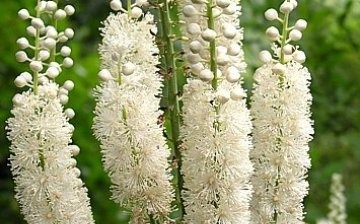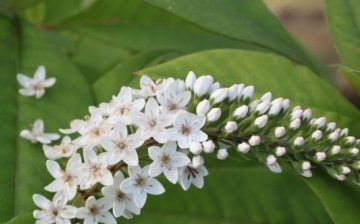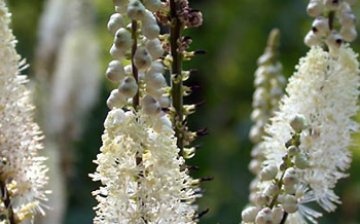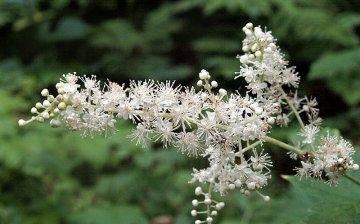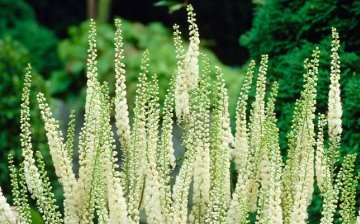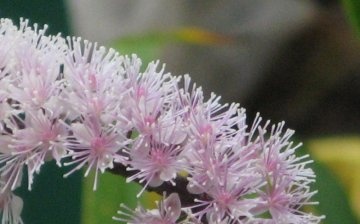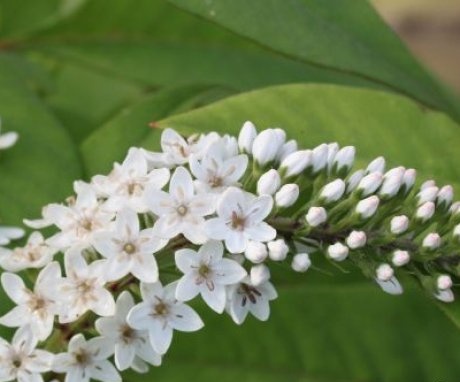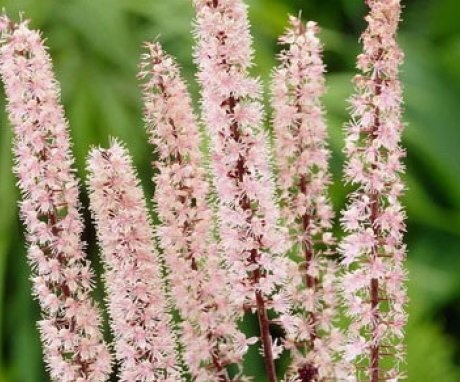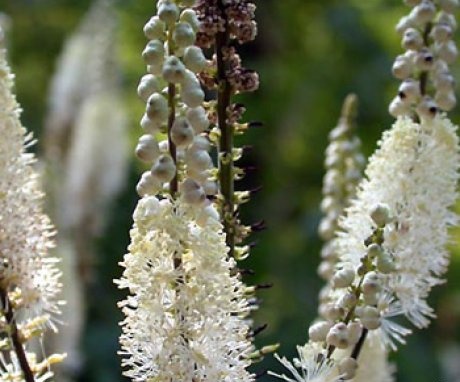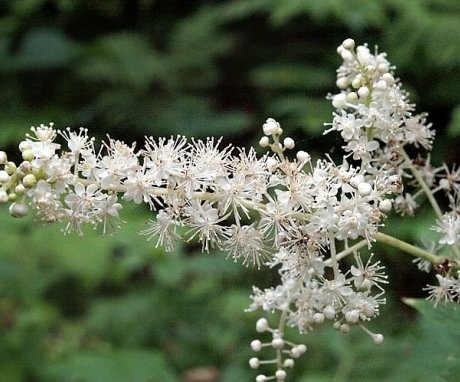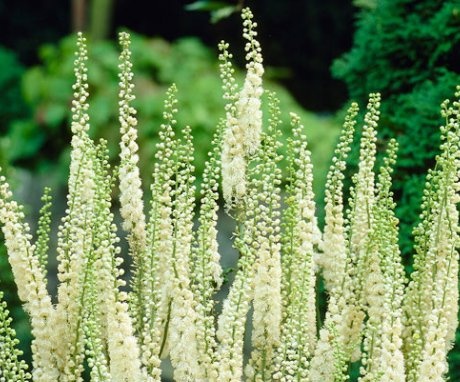Black cohosh: characteristics, varieties, planting and plant care
The vast majority of colorful flowers prefer sunny areas. Black cohosh, undemanding to light, will allow you to brightly decorate shady corners of the garden.
Content:
- Tsimicifuga in detail
- Popular varieties of black cohosh
- Plant care secrets
- How to breed black cohosh?
- Application in landscape design
- Interesting information about the culture
Tsimicifuga in detail
The plant is herbaceous perennial from the Buttercup family. In botany, about 15 species of culture are described, differing from each other in terms of flowering.
Under natural conditions, black cohosh is found in Siberia, European mountains, temperate latitudes of North America, China, Mongolia, the Far East and the Japanese islands. The Russian climate is quite suitable for all species: they are not afraid of the cold and will calmly endure spring frosts.
The word "cimicifuga" literally translated from Latin means "chasing bed bugs". The flower owes such a dissonant name to black cohosh, which is used as an insecticide.
Even with minor damage, perennials release an unpleasant-smelling substance into the environment. For this unpleasant property, the plant was popularly dubbed "an ordinary stinker" or "stuffy root".
It is this species that is rarely found in the garden. For the decoration of plots, other varieties of cimicifuga are used, which have a pleasant aroma. The German version of the culture's name ("silver candles") more accurately characterizes these elegant flowers.
Black cohosh is a colorful structural plant. Its leaves resemble huge parsley, extending from a thick, rather high stem (up to 2 m). Inflorescences are spike-shaped (fluffy candles) or racemose.
In late summer, the bush adorns the garden with white or cream flowers.
If the weather is cool for a long time, the cimicifuga may not throw out the inflorescences. Distinctive features of the plant are vitality, unpretentiousness, frost resistance and longevity. Until the age of 25, it will calmly grow in one place, becoming more and more beautiful every year. A dissonant name should not cause a bias towards the flower, because this is a colorful and spectacular plant.
Popular varieties of black cohosh
Different types of cimicifugi differ from each other in appearance, but each of them is undoubtedly of interest to gardeners.
The most famous perennials:
- Black cohosh is branched. Height - about 2 m. Small creamy flowers form huge elongated inflorescences. The leaves are chocolate red, bronze or dark cherry. Blooms very late, in September. In a rainy summer, it may not have time to throw out the inflorescences, and therefore it is not recommended to plant it in full shade.
- Black cohosh is simple. A distinctive feature is the relatively small drooping inflorescences, consisting of small flowers. A cloudy summer is a threat to the plant: it may not bloom. The Brunet variety is popular among gardeners: its bronze-chocolate foliage does not tarnish throughout the season. The white flowers bloom and turn purple.
- Black cohosh racemose (cimicifuga racemosis).The graceful perennial grows up to 2 m in height. Fragrant candle-shaped inflorescences (up to 80 cm long) bloom from bottom to top. White or creamy flowers appear from July to September.
- Black cohosh is smelly. A distinctive feature is the unpleasant smell of the aerial part of the plant and the rhizome itself. One of the popular names - Adam's rib - the flower received for the lower leaves similar to ribs. An adult shrub grows up to 2 m. The foliage is large, feathery. Small light green flowers are collected in a paniculate inflorescence.
- Black cohosh American. Reaches 90-150 cm in height. Leaves are dense, rich green hue. From July to August, the plant throws out cylindrical inflorescences-brushes, consisting of small grayish-beige flowers. It is appreciated for its high decorative effect.
- Black cohosh daurian. Height - about 1 m. Fluffy inflorescences - branched long candles. They droop slightly under the weight of small white flowers.
Very beautiful cimicifugi differ from each other in terms of flowering, size and shade of inflorescences.
Plant care secrets
A novice gardener will also be able to create comfortable conditions for a cimicifuga. Factors affecting the condition of the flower:
- Black cohosh will do well in the sun and shade. The main thing is to shelter from drafts that can destroy the plant. It is not recommended to place it too close to trees, as their roots will take up some of the moisture and nutrients intended for the perennial.
- When planting a flower, it is worth considering its rather large dimensions. An adult occupies a fairly large area, but the bush itself is sparse.
- Black cohosh is suitable for moist, loose, humus-rich soil. Soil mulching is a way to retain moisture. Mulch is not used near the base of the plant to prevent water stagnation and stem decay. In drought, regular watering and spraying is necessary.
- During the growing season, perennials are fed. Mineral fertilizers are applied according to the instructions.
- A powerful-looking plant may not withstand strong winds. To prevent the flower stalks from breaking, they should be tied up. This is especially true for tall specimens.
- The strong foliage of the cimicifuga prevents weeds from growing. When the bush grows, there is practically no need to weed. Diseases and pests do not annoy the plant.
- In the fall, faded panicles are cut (if seeds are not needed) to preserve the beautiful appearance of the bush. The attention is focused on interesting leaves.
- The flower is being prepared for wintering. With the onset of late autumn, its stems are completely cut off.
- Although the perennial is resistant to cold, it is worth covering it with fallen leaves. This is a protection for the rhizome that has grown upward, which is especially important for ornamental varieties. The delicate species may not survive the harsh winter.
Caring for a cimicifuga is not at all burdensome and is quite capable of even for amateur gardeners.
How to breed black cohosh?
You can cultivate a plant with seeds, dividing the bush and cuttings. As for the first method, the opinions of experts differ. Some recommend sowing the planting material immediately after harvesting.
According to other sources, it is worth carrying out a six-month seed stratification. The first 3 months they are kept dry at a temperature of 200C. For the next 90 days, the planting material is determined in a refrigerator (temperature 40C). After such procedures, the embryo develops, germination increases. The grown seedlings are determined to a permanent place together with an earthen lump. The plants obtained in this way will bloom in 2-3 years.
In the middle lane, not all black cohosh varieties ripen seeds. For the reproduction of these perennials, it is impossible to apply the method described above.
It is preferable to divide an adult bush with the arrival of spring. 5-6-year-old specimens are suitable for the procedure. It should be borne in mind that the rhizome of the cimicifuga is very stiff. You will have to work with a sharp ax or shovel.
Having dug up the mother plant, separate the daughter buds with sprouts. In order for the delenki to take root, they are placed in the shade and watered generously. The mother liquor is returned to its original place.
You can try to separate the bud with roots from an adult bush without disturbing its root. Some professionals recommend tearing off the leaf with the "heel" near the stem. It is dug into the ground and covered with a plastic bottle.
For grafting, green shoots that appear in early spring are suitable.
If the favorable time is missed, the black cohosh cannot be propagated in this way. In June, the stems will become stiff and will not be able to take root. The harvested cuttings are placed in heat until rooting. Then they are planted in flower beds. For each cimicifuga, you can choose the optimal breeding method, taking into account the varietal characteristics.
Application in landscape design
Culture is confidently gaining its place in the gardens. Europe is importing many new and interesting plant species for professionals. The latest novelty is a variety in which the buds have not yet blossomed are raspberry-colored. Black cohosh is gaining in popularity every year.
Black cohosh planting site:
- In single plantings, two-meter giant cimicifugi are used. Borders, shaded flower beds are decorated with compact bushes (height 40 cm).
- Perennials look perfect in the background of a flower garden, near water bodies. They effectively decorate a log wall of a house or a wooden fence. Against the background of green thuja, openwork inflorescences look especially picturesque.
- Plants that are also partial to shade and wet soil will be good partners for black cohosh. These requirements are met anemone japanese, aconite, astilba and hosts. If we add to this variety fern, sedge, you get a "forest in miniature". Climbing plants will fill the voids (lungwort, Brunner large-leaved).
- Planting together with ground cover plants is very important for black cohosh. They prevent the soil from drying out quickly, which negatively affects the condition of the bush.
- Designers advise choosing neighbors with red or purple flowers for the cimicifuga. A lily, columbine or Solomon print will do.
By correctly combining black cohosh and other plants, you can create simply amazing landscapes.
Interesting information about the culture
Tsimitsifuga is not only pleasing to the eye, but also famous for its healing properties. Chinese medicine pays tribute to the black cohosh as a sacred plant. The North American Indians knew that the perennial helps to defeat many diseases.
The healing effect is due to the beneficial substances in the composition of the flower.
Plant components:
- Flavonoids
- Saponins
- Alkaloids
- Tannins
- Phenolcarboxylic acids
- Resins
- Sterols
Application in medicine:
- Strengthening immunity, increasing the protective properties of the body.
- Helps with swelling and swelling due to its anti-mutagenic and diuretic properties.
- Antihypertensive agent.
- Fights atherosclerosis and diabetes.
- Heals gynecological diseases caused by insufficient production of female sex hormones.
- Prevents arthritis and osteoporosis.
- Acts on cataracts.
- Improves the condition in diseases of the cardiovascular system.
Eastern medicine widely uses black cohosh decoction. In China, it is prescribed for toothache, skin rashes and measles. They are treated with gastro- and enterocolitis, prolapse of the uterus. Korean doctors prescribe tsimicifugi decoction for skin irritation caused by allergies.
The lion's share of nutrients is in the rhizome of the plant. It is from it that effective tinctures and decoctions are prepared. Black cohosh flowers, although beautiful, are absolutely useless in terms of treatment.
Today, the perennial has not yet revealed all its secrets. It is under the scrutiny of scientists who are trying to find out about all the healing properties of the plant.
Tsimitsifuga is not just a beautiful perennial, but also a well-known medicinal plant.
Those who decide to plant a black cohosh in their garden will surely receive a reward in the form of an attractive, interesting bush. The best part is that with age, it will only become more beautiful, attracting everyone's attention.
More information can be found in the video.



